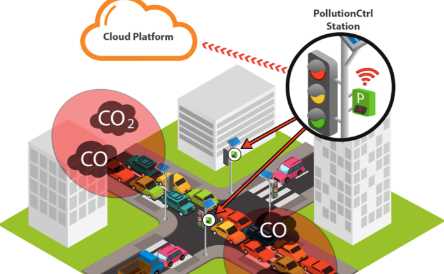The Internet of Things (IoT) has revolutionized the way we live our lives. It has enabled us to connect all sorts of devices and sensors, making it possible to collect and analyze data in real-time. The IoT has the potential to help us address one of the most pressing environmental issues of our time: air pollution. In this article, we will explore how IoT can reduce air pollution and make our cities cleaner and healthier.
Smart Transportation
Transportation is a major contributor to air pollution. According to the Environmental Protection Agency (EPA), transportation accounts for 28% of greenhouse gas emissions in the United States. Smart transportation systems powered by IoT can help reduce these emissions by optimizing traffic flow, reducing congestion, and promoting the use of cleaner modes of transportation such as electric cars and bicycles.
IoT-enabled sensors can collect real-time data on traffic flow, vehicle speed, and road conditions. This data can be analyzed to optimize traffic flow, reducing congestion and the time that vehicles spend idling in traffic. This can reduce emissions from cars and trucks, as well as improve air quality in surrounding areas.
Smart transportation systems can also promote the use of cleaner modes of transportation. For example, IoT-powered bike-sharing systems can provide real-time data on bike availability, helping people find bikes when they need them. Electric car charging stations can also be integrated into these systems, making it easier for people to switch to electric vehicles.
Air Quality Monitoring
One of the biggest challenges in reducing air pollution is understanding where it comes from and how it affects people's health. IoT can help by providing real-time data on air quality, enabling policymakers to take action to reduce pollution levels.
IoT-enabled sensors can be installed throughout cities to monitor air quality in real-time. These sensors can collect data on the levels of pollutants such as nitrogen oxides, particulate matter, and ozone. This data can be used to create detailed air quality maps, which can help policymakers identify areas where pollution levels are particularly high.
Real-time air quality data can also be used to alert people to high pollution levels. This can be done through mobile apps that provide real-time air quality information, or through smart home devices that can automatically adjust air filtration systems to protect indoor air quality.
Industrial IoT
Industrial processes are another major contributor to air pollution. The Industrial Internet of Things (IIoT) can help reduce pollution by optimizing industrial processes and reducing waste.
IIoT-powered sensors can be used to monitor industrial processes in real-time, collecting data on energy usage, emissions, and waste production. This data can be analyzed to optimize processes, reducing waste and energy usage, and improving overall efficiency.
IIoT can also help reduce emissions from industrial processes by enabling the use of cleaner energy sources. For example, sensors can be used to monitor renewable energy sources such as solar panels and wind turbines, optimizing their output and reducing the need for fossil fuels.
Smart Homes
The air quality inside homes can also have a significant impact on people's health. IoT can help improve indoor air quality by enabling the use of smart home devices that monitor and control air quality.
IoT-enabled air quality sensors can be installed in homes to monitor indoor air quality in real-time. These sensors can collect data on the levels of pollutants such as dust, mold, and volatile organic compounds (VOCs). This data can be used to identify sources of pollution and take action to reduce their impact.
Smart home devices such as air purifiers and HVAC systems can also be integrated with IoT-enabled sensors to automatically adjust air quality settings based on real-time data. This can help reduce the levels of pollutants in the air and improve indoor air quality.




Leave Comment